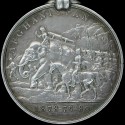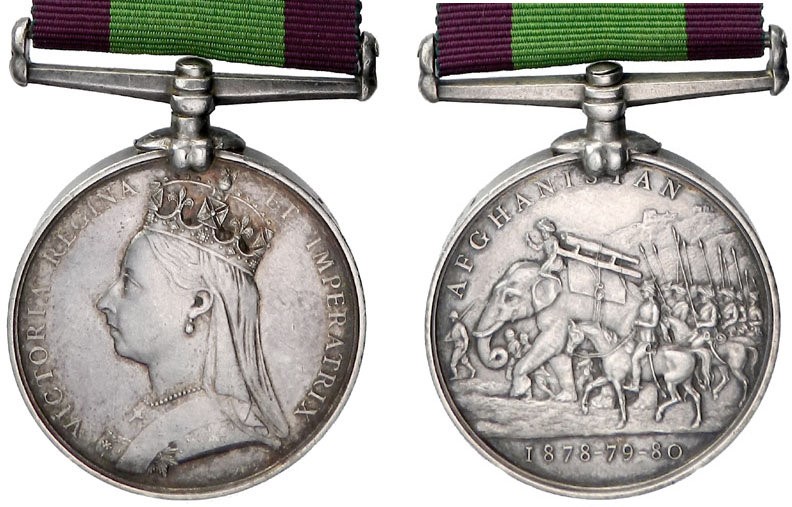A Scion Society of The Baker Street Irregulars

Dr. Watson’s Afghanistan Campaign Medal
“The campaign brought honours and promotion to many, but for me it had nothing but misfortune and disaster.”
– A Study In Scarlet (STUD)
With that comment, within the first two hundred words of STUD, we are given a strong viewpoint of Dr Watson’s regarding his participation in the Second Anglo-Afghanistan War of 1878 – 1880. That said, Dr Watson was honoured, as were all surviving troops that took part in the skirmishes of that conflict, for service to Queen and country.
Before we discuss the Afghan campaign medal, let’s review Great Britain’s history of involvement with Afghanistan and the circumstances leading to the Second Anglo-Afghanistan War.
Great Britain had a major presence in Asia since the formation of the British East India Company in 1612. After the Battle of Plassey in 1757, the company effectively ran large areas of what is India. After the end of the Napoleonic Wars in 1815, the governments of Great Britain and Russia vied for influence on the central Asian subcontinent.
British fears of a Russian invasion of India from the north became magnified in 1838 when a Russian envoy met with the Amir of Afghanistan to form an alliance of the two nations. The British Governor-General of India formed an army of 21,000 troops and invaded Afghanistan in late 1838. By August 1839, the British and Indian troops succeeded in establishing a pro-British ruler in the Afghan capital city of Kabul.
Troops remaining in Afghanistan, to support the pro-British ruler’s reign, became under increasing threats and attacks. In 1842, the British began withdrawing from Afghanistan, and by October of that year, the previously deposed Amir was back in Power. Over 4,000 of the British and Indian troops were killed during the First Anglo-Afghanistan War.
Over the next 30 years, Great Britain and Russia continued to “play the Great Game” in central Asia, and Russia continued to slowly expand its influence south towards Afghanistan.
In the summer of 1878, Russia again sent envoys to Afghanistan. In August 1878, the British demanded that the Afghans also receive a British delegation. The Afghans, who were unsuccessful in stopping the arrival of the Russians in July, were able to turn back the British in September. This is considered the start of the Second Anglo-Afghan War.
Approximately 50,000 troops invaded Afghanistan in early 1879. By May, British forces occupied a majority of the country and a treaty was signed that gave the British control of the Afghanistan’s foreign policies. British troops withdrew and returned to India.
An uprising in Kabul on September 3, 1879 resulted in the death of the British representatives. British troops returned and invaded Afghanistan in October. Over the next 18 months, many battles, sieges and actions were to take place. To highlight a few –
Battle of Ali Musjid – November 21, 1878
Battle of Peiwar Kotal – November 28-29, 1878
Battle of Charasia – October 6, 1879
Siege of Kabul – December 1879
Battle of Ahmed Khel – April 19, 1880
Dr Watson wrote that, in 1878 after getting his Doctor of Medicine from the University of London, he underwent training, at Netley, for surgeons in the army and became attached to the Fifth Northumberland Fusiliers as an Assistant Surgeon. Before he could meet up with them in India, the Second Afghan War had broken out. Assuming that Dr Watson would join his fellow troops in early 1879, there is no mention of his participation in any military actions until he “served at the fatal battle of Maiwand.”
Elliott Kimball, author of Dr John H Watson At Netley, theorizes that Watson began his studies at Netley in October 1879 and finished them in March of 1880. According to Kimball, Watson was travelling on the Continent for personal reasons from June 1878 until October 1879. Utilizing these dates could justify that Watson’s first military action was at Maiwand on July 27, 1880.

The Afghanistan Medal
Watson’s service in Afghanistan makes him eligible to receive the Afghanistan Medal, a 36mm round, silver medal (some examples are known in bronze), with a 33mm wide dark green ribbon with crimson on both edges. The medal hangs from a plain suspender that has a double toe claw to hold the medal.
A left-facing bust of Queen Victoria is on the obverse (or front) of the medal. The legend of VICTORIA REGINA ET IMPERATRIX is around the border of the design. This profile of Victoria was designed by Joseph Boehm.
The central design of the reverse (or back) of the medal features an elephant carrying a cannon, with soldiers, marching and on horseback Below this is the dates 1878-79-80. In the upper left, above the design, is the word AFGHANISTAN. This design was done by Randolph Caldecott, an illustrator of children’s books.
The medal was engraved by Leonard Wyon of the British Royal Mint.

A preview of the medal, with clasps, from the September 1881 The Graphic
In addition to the medal, six plain silver clasps were awarded for participants in the five battles mentioned earlier in this article and for the final battle at Kandahar on September 1, 1880. In a cruel twist of fate, these clasps were only issued for battles that the British troops were victorious. As a consequence, Dr Watson and the other survivors of Maiwand do not have a clasp for their heroic efforts.
Luckily, the wounded Watson was saved by his orderly, Murray, and brought to safety behind British lines. Having been sent to the hospital at Peshawur and then being stricken with enteric fever, it is extremely improbable that Watson would have been able to participate in the 320-mile march from Kabul to Kandahar that began August 9th. This makes Watson ineligible to receive the Kabul to Kandahar Star, also known as the Roberts Star, in honor of General Frederick Roberts. The men of the 66th who fell back to Kandahar and fought in the resultant siege would have received the Kandahar clasp. If, per STUD, Watson was in Peshawur, then he would not have went through the Siege of Kandahar and his Afghanistan Medal would have no clasp. If, as some scholars maintain, that Watson was at Kandahar, then his medal would have the Kandahar clasp.
Many of the chronologists for the stories of the Canon have STUD occurring on Friday, March 4, 1881. If Dr Watson wrote up his narrative in the days after the case, there would have been no Afghanistan Medal to honour him and the others who served in Afghanistan. The medal was not established until March 19, 1881 and the design was first revealed until August of that year.
Perhaps we now know why the good Doctor was bitter……
This article was originally published in the Spring 2016 issue of The Watsonian, Volume 4, Number 1
The Watsonian is the official publication of the John H Watson Society and is edited by the 28th Garrideb, James C. O’Leary. Beth Gallego, the 39th Garrideb, currently serves as Selena Buttons for the JHWS.

This story was highlighted in the June 5, 2016 issue of The E-Sylum and can be viewed at http://coinbooks.org/esylum_v19n23a28.html.
[…] In addition, we glean that Colonel Moran served during the Afghan campaign and would have earned the Afghanistan Campaign Medal. The mentions of Charasiab and Cabul indicate that his campaign medal would have two clasps, one for each. We’ve discussed this medal before HERE and in more detail HERE. […]
[…] 6th Garrideb, Greg Ruby, contributed Dr Watson’s Afghan Campaign Medal, which we reprinted HERE. Seriously, half of the articles in this journal were authored by Garridebs and a tip of the hat to […]
[…] our previous post on Dr. Watson’s Afghanistan Campaign Medal, we briefly discussed the Kabul to Kandarhar Star (also known as the Robert’s […]